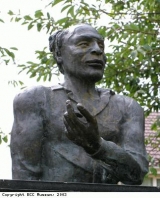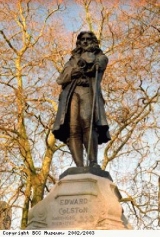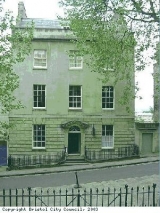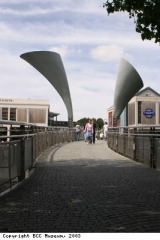Monuments to individuals
There are many statues in Bristol. One of the most prominent, in the Centre, was erected in 1895 to the memory of Edward Colston. This statue lists the many good works done by Bristol’s ‘Great Benefactor’, a merchant in the 17th century. But it makes no mention of his role as a highly placed officer in the Royal African Company. The Royal African Company held from 1672 to 1698, the sole British rights to trade with Africa for gold, ivory, spices and slaves.
In 1998, when information about Colston’s involvement in the slave trade became better known, the statue was vandalised. A furious public debate ensued in the pages of the local papers about whether or not the statue should be taken down or whether a more truthful inscription should be added, telling about his involvement in slavery. Many white Bristolians resented this questioning of the reputation of the city’s most generous benefactor (he gave the equivalent today of about £10 million to schools, churches and charities for the poor in Bristol). To date (late 2003) nothing has happened to the statue. The debate still continues. It has been given an added twist by the debate over the Colston Hall. This concert hall, named after Edward Colston and standing in Colston Street, has become a focus of the Colston debate. It is the major concert hall for the city, hosting rock and pop concerts as well as orchestral concerts, stand-up comedy and wrestling. High profile Bristol band, Massive Attack, have refused to play at the Hall because of its name and the link of the hall’s name to slavery. A recent debate about changing the name of the hall resulted in a poll by the local paper being overwhelmingly in favour of keeping the name Colston Hall. It is a debate that may continue for some time. Interestingly (or ironically?) the Colston Hall stands on the site of the Great House, where the city’s first recorded black resident worked as a gardener in the late 1500s. And it was the site of Bristol’s first sugar refinery, where slave-produced sugar from the Caribbean plantations was processed from 1653 until 1708.
There is only one statue to a black person in Bristol. It is of the writer and playwright Alfred Fagon. It stands on the green at the junction of Ashley Road and Grosvenor Road in the St Pauls area. Alfred Fagon was born on the Caribbean island of Jamaica in 1937. He came to Britain, and spent some years in Bristol. He was an actor and writer, with four stage plays and one television play to his credit. He died of a heart attack at the age of 49, in the prime of his career. There is now this bronze statue to his memory, sculpted by David G. Mutasa and commissioned by the Friends of Fagon Committee. There is also an Alfred Fagon Award, funded by the Peggy Ramsay Foundation. This was first awarded in 1997, and is given annually for the best new play for the theatre in English by a writer from the Caribbean or with Caribbean antecedents. Fagon’s plays are published and are currently in print.
In 1999, a new footbridge (pictured here) was opened across a stretch of water called St Augustine’s Reach on the River Frome in the centre of Bristol. Designed by the artist Eilis O’Connell and built by engineers Arup, it is a ‘bascule’ bridge. This means that the centre section lifts up to allow large boats to pass into and out of Narrow Quay. The City Council asked for suggestions for a name for the bridge. Pero’s Bridge was suggested and supported by black groups and by Bristol’s Member of the European Parliament, Ian White. The name comes from Pero Jones, who was born a slave on the island of Nevis in the Caribbean. He was bought at the age of about 12 by John Pinney, a plantation owner. Pero became Pinney’s manservant, a house servant rather than a field servant. When Pinney moved to Bristol in 1783, Pero came with him. He continued as Pinney’s manservant until his death. He worked in his master’s house, 7 Great George Street, which served as Pinney’s home and as offices for his sugar trading business. Pero died in 1798. As far as is known, he was never freed by his owner, so he was born, lived and died a slave. The plaque beside the bridge dedicates the bridge to Pero.






